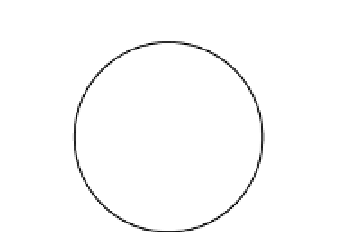Game Development Reference
In-Depth Information
In looking at Equation (7.37), we see that the distance traveled during the skid phase does
depend on the coefficient of friction between the ball and putting green. The coefficient of
sliding friction between the ball and green will typically range from 0.4 to 0.5.
3
The Rolling Phase
After the skid is complete, we can assume the golf ball to be in a pure rolling motion across the
green. Even though the ball is no longer sliding, and therefore there is no force due to sliding
friction, the ball will eventually slow down and come to rest. According to Newton's second
law, if a body slows down, a force is acting upon it. In this case, the golf ball slows down due to
the force of
rolling friction
.
Rolling friction is somewhat misnamed because it really is a force due to the contact of the
golf ball and the green. When a golf ball, or any other object, rolls on a surface, both the golf ball
and the surface it is rolling on are slightly deformed by the force each object exerts on the other.
This deformation moves the effective point of contact between the ball and green slightly
forward on the golf ball as shown in Figure 7-11.
ω
b
F
contact
F
N
= mg
F
r
Figure 7-11.
The contact force on a rolling object acts slightly forward of the center of gravity.
The normal component of the contact force,
F
N
, is equal to
mg
(or
mg
cos
q
if the ball is
rolling on an inclined surface). The parallel component of the contact force,
F
r
, is known as the
force of rolling friction. While it is essentially a contact force, rolling friction is modeled similar
to the force of static or sliding friction. The magnitude of the rolling friction force is equal to the
normal force exerted on the ball multiplied by the coefficient of rolling friction,
m
r
.
F
=
m
g
(7.38)
r
r
Rolling friction acts to slow a rolling object down. For a ball rolling on a flat surface, the
velocity of the golf ball at any time during the roll will be equal to the initial velocity minus the
acceleration due to rolling friction.
vv
=−
m
t
(7.39)
b
br
r
The total distance traveled by the golf ball until it stops can be computed from the standard
Newtonian mechanics relation.
2
1
1
v
xvt
=+
t
2
=
br
(7.40)
br
2
2
m
g
r







